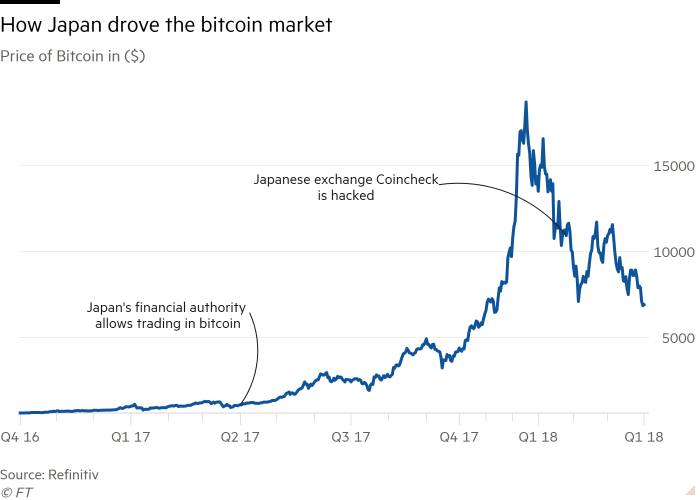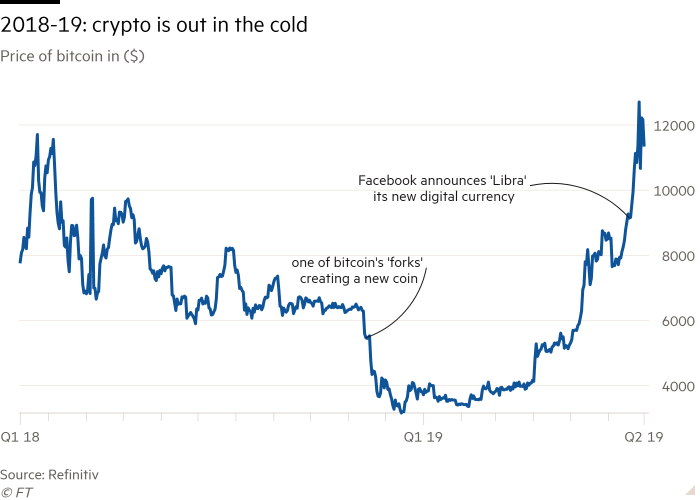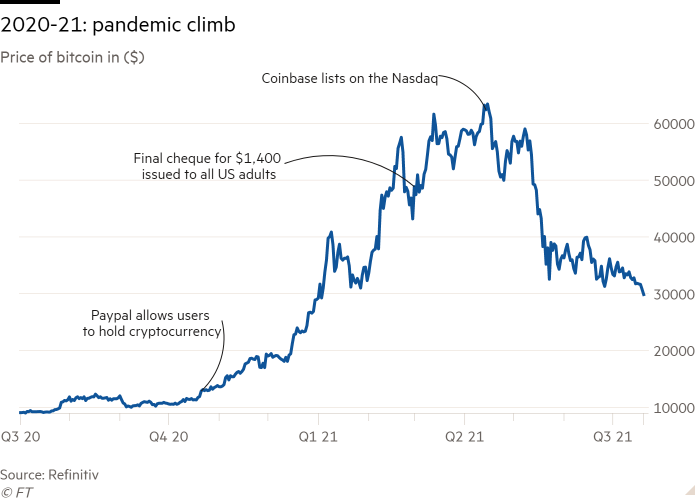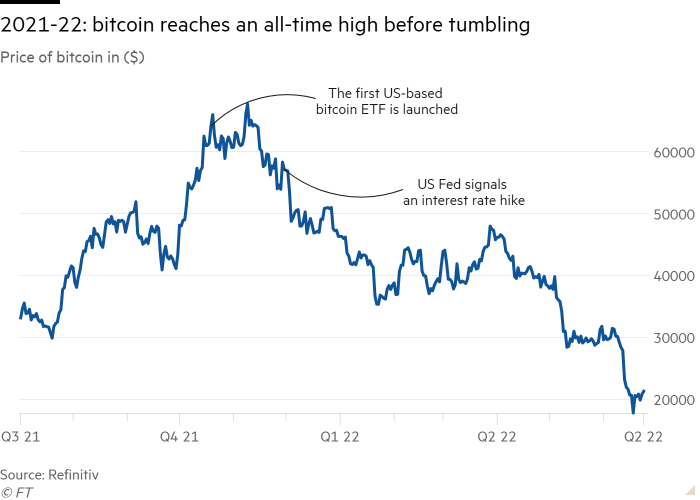What can the past tell us about the future of bitcoin?
Bitcoin has crashed in value by more than 50 percent in the last six months, but holders of the cryptocurrency are used to volatility. Here we look at how FT covered bitcoin’s previous boom and bust to see if history repeats itself.

The Japanese boom and bust (April 2017 to March 2018)
Prior to 2017, bitcoin traded for under $ 1,000. But on New Year’s Day 2017, the cryptocurrency broke past the $ 1000 level, and by the end of the year it had risen to within touching range of $ 20,000.
The boom was triggered by a rush of interest, first in Japan and then in South Korea. Small investors began to gamble on bitcoin, drawn in by primetime TV commercials and billboards boasting high returns. After Japan approved trading on 11 crypto exchanges in April 2017, the country accounted for around 40 percent of daily trading activity worldwide.
But a crash soon followed. At the beginning of 2018, so-called bitcoin “whales”, the largest holders of the cryptocurrency, began to withdraw money to take advantage of the high prices. The mood became so bad when the Japanese stock exchange Coincheck was hacked, and lost $ 530 million of XEM, another popular cryptocurrency.

Although no bitcoin was stolen, the hack annoyed small investors, who worried about the security of holding digital currencies, especially after the Japanese Financial Supervisory Authority raided Coincheck’s offices in February.
The first bitcoin winter (March 2018 to May 2019)
Between March 2018 and May 2019, Bitcoin traded below $ 10,000 when critics and regulators expressed doubts about the future.
In London, for example, traders and institutions were wary of engaging in cryptocurrencies due to fears of fraud, financial crime and other reputational risks.
The fire sale in early 2018 of bitcoin whales led to concerns about the influence of large accounts on the price of cryptocurrency. In April 2018, around 1,600 bitcoin wallets held almost a third of all available bitcoin. Of these, 100 wallets contained over 10,000 bitcoin.

The Winklevoss twins
Cameron and Tyler Winklevoss, for example, who were best known for unsuccessfully suing Mark Zuckerberg over the idea of becoming Facebook, were some of the biggest whales, buying reportedly 120,000 bitcoins in 2012.
The winter deepened after a battle for a fork in the cryptocurrency, when new versions of bitcoin were created, sending the price to the lowest level since the beginning of 2017.

But in June, bitcoin received a boost from an unexpected source: Facebook. The world’s largest social media company unveiled plans for Libra, its own digital currency. While Libra ultimately remained just a dream, the news that Facebook planned to enter the sector aroused confidence in bitcoin’s sustainability.
Pandemic boom (October 2020 to April 2021)
After the initial shock of the coronavirus pandemic, bitcoin began to gain ground after PayPal announced that it would begin allowing users to hold cryptocurrencies.
Stuck in the lockdown, and with government stimulus checks to use, retail investors began to play on the rise of bitcoin. In six months, the cryptocurrency rose from less than $ 12,000 to over $ 63,000.
The steep rise also caught the attention of institutional investors, and tensions peaked with the initial listing of Coinbase, the largest crypto exchange, which opened at a value of nearly $ 76 billion on the Nasdaq in April 2021.

But the height did not last long. China banned crypto-mining, the use of computers to solve riddles to earn cryptocurrencies, in September 2021, although activity quickly shifted to other countries.
Then the United States and Europe again raised the prospect of regulation.
Eventually, day traders were caught in a frenzy of meme stocks, many of whom took out bitcoin to play in the stock markets, and more fears were raised, including by Elon Musk, about the environmental costs of crypto mining. Bitcoin fell to a low of just under $ 30,000 at the end of July.

Days after the bitcoin ETF began trading, the cryptocurrency reached a record high
Bitcoin suffers when stock markets fall (July 2021 to today)
Bitcoin fans initially insisted that it was a hedge against inflation and immune to fluctuations in other markets.
In October 2021, the cryptocurrency became full mainstream with the launch of an exchange traded fund, which made it possible for investors to have exposure to ups and downs without having any bitcoin directly. Days after the ETF began trading, bitcoin reached a record high of almost $ 69,000.
But as a mainstream asset, wealth has become much more in line with broader market sentiment.

Fears in the US economy in early December of rising inflation and future interest rate hikes caused bitcoin’s exchange rates to fall sharply, and in the following months bitcoin fell in line with the decline in US technology stocks.
As inflation worsened this year, bitcoin suffered further and in June had its worst week since 2020. ProShares, the company behind the first bitcoin EFT, launched a new fund to profit from the fall of bitcoin.
What comes next?
Bitcoin’s past boom has all been driven by small investors rushing into the market, hoping to make a remarkable profit in a short time. The subsequent crashes have come as regulators, the wider market or concerns about the risk in the sector that scared bitcoin holders to withdraw money.
These trends seem to continue. As Katie Martin, author of FT’s Long View column, said, bitcoin is “the most speculative asset on the planet, possibly even the most speculative of all time.”
Looking ahead, while regulators have promised to be “relentlessly harsh”, it is still largely unclear how any future rules around the cryptocurrency will work in practice. But there is more evidence for overall thinking, and if regulators succeed in setting rules, they will help the crypto industry build more trust, and perhaps ultimately deliver some stability.


